Performance Study of F-P Pressure Sensor Based on Three-Wavelength Demodulation: High-Temperature, High-Pressure, and High-Dynamic Measurements
Abstract
:1. Introduction
2. Materials and Methods
- The dynamic sampling point calculation, when , can be shown in Figure 2a, which is the moment of the occurrence of phase jump. The setting of the phase threshold is related to the sampling rate; the higher the sampling rate, the closer the threshold is to π. In this paper, we experimentally measured whether setting the threshold to 3 can adapt to the phase mutation problem at the sampling rate of 100 Hz~200 kHz.
- Compensate for the change in lumen length, calculated before the jump to the initial lumen length as .
- Recalculate the initial phase according to Equation (3).
- Recalculate Equations (6)–(8) at the jump point to obtain the compensated cavity length value as .
3. Results
3.1. Construction of a Sensor Static Pressure Test Setup
3.2. Room Temperature and Static Pressure Test Results
3.3. High-Temperature Static Pressure Test Results
3.4. Dynamic Pressure Test Results
4. Discussion
5. Conclusions
Author Contributions
Funding
Institutional Review Board Statement
Informed Consent Statement
Data Availability Statement
Conflicts of Interest
References
- Chen, Y.; Xu, Q.; Zhang, X.; Kuang, M. Materials and Sensing Mechanisms for High-Temperature Pressure Sensors: A Review. IEEE Sens. J. 2023, 23, 26910–26924. [Google Scholar] [CrossRef]
- Yao, Z.; Liang, T.; Jia, P.; Hong, Y.; Qi, L.; Lei, C.; Zhang, B.; Xiong, J. A High-Temperature Piezoresistive Pressure Sensor with an Integrated Signal-Conditioning Circuit. Sensors 2016, 16, 913. [Google Scholar] [CrossRef] [PubMed]
- Ren, J.; Ward, M.; Kinnell, P.; Craddock, R.; Wei, X. Plastic Deformation of Micromachined Silicon Diaphragms with a Sealed Cavity at High Temperatures. Sensors 2016, 16, 204. [Google Scholar] [CrossRef] [PubMed]
- Chen, L.; Tian, J.; Wu, Q.; Li, J.; Yao, Y.; Wang, J. Temperature-Insensitive Gas Pressure Sensor Based on Photonic Crystal Fiber Interferometer. IEEE Sens. J. 2023, 23, 15637–15643. [Google Scholar] [CrossRef]
- Zhang, Y.; Jiang, Y.; Deng, H.; Gao, H.; Tang, C.; Wang, X. All-sapphire-based optical fiber pressure sensor with an ultra-wide pressure range based on femtosecond laser micromachining and direct bonding. Opt. Express 2023, 31, 41967–41978. [Google Scholar] [CrossRef] [PubMed]
- Shao, M.; Cao, Z.; Gao, H.; Yu, D.; Qiao, X. Optical fiber ultrasonic sensor based on partial filling PDMS in hollow-core fiber. Opt. Laser Technol. 2023, 167, 109648. [Google Scholar] [CrossRef]
- Fan, H.; Zhang, L.; Gao, S.; Chen, L.; Bao, X. Ultrasound sensing based on an in-fiber dual-cavity Fabry–Perot interferometer. Opt. Lett. 2019, 44, 3606–3609. [Google Scholar] [CrossRef] [PubMed]
- Wong, K.P.; Kim, H.-T.; Rajasekaran, K.; Yazdkhasti, A.; Sai Sudhakar, B.; Wang, A.; Lee, S.E.; Kiger, K.; Duncan, J.H.; Yu, M. High-speed, large dynamic range spectral domain interrogation of fiber-optic Fabry–Perot interferometric sensors. Appl. Opt. 2022, 61, 4670–4677. [Google Scholar] [CrossRef]
- Guo, T.; Zhang, T.; Qiao, X. FBG-EFPI sensor for large strain measurement with low temperature crosstalk. Opt. Commun. 2020, 473, 125945. [Google Scholar] [CrossRef]
- Zhang, J.; Zhao, X.; Zheng, Y.; Chen, J.; Bai, J.; Wu, L.; Gao, X.; Li, Z.; Xue, C. A Wide Frequency Response Fabry–Pérot Acoustic Sensor Based on the Self-Stabilization System. IEEE Sens. J. 2023, 23, 16922–16929. [Google Scholar] [CrossRef]
- Hu, X.; Su, D.; Qiao, X. Highly sensitive optical fiber pressure sensor based on the FPI and Vernier effect via femtosecond laser plane-by-plane writing technology. Appl. Opt. 2024, 63, 2658–2666. [Google Scholar] [CrossRef] [PubMed]
- Zhang, Y.; Jiang, Y. An All-Sapphire Fiber Diaphragm-Free Extrinsic Fabry–Perot Interferometric Sensor for the Measurement of Gas Pressure at Ultrahigh Temperature. IEEE Sens. J. 2023, 23, 5818–5823. [Google Scholar] [CrossRef]
- Jian, T.; Guolu, Y.; Changrui, L.; Shen, L.; Zhengyong, L.; Xiaoyong, Z.; Qiao, W.; Jing, Z.; Kaiming, Y.; Yiping, W. High-Sensitivity Gas Pressure Sensor Based on Fabry–Pérot Interferometer with a Side-Opened Channel in Hollow-Core Photonic Bandgap Fiber. IEEE Photonics J. 2015, 7, 6803307. [Google Scholar] [CrossRef]
- Li, Z.; Tian, J.; Jiao, Y.; Sun, Y.; Yao, Y. Simultaneous Measurement of Air Pressure and Temperature Using Fiber-Optic Cascaded Fabry–Perot Interferometer. IEEE Photonics J. 2019, 11, 7100410. [Google Scholar] [CrossRef]
- Ma, W.; Jiang, Y.; Gao, H. Miniature all-fiber extrinsic Fabry–Pérot interferometric sensor for high-pressure sensing under high-temperature conditions. Meas. Sci. Technol. 2019, 30, 025104. [Google Scholar] [CrossRef]
- Liu, W.; Yang, T.; Shi, Y.; Wu, J.; Dong, Y. Combined Interrogation Algorithm of Phase Function and Minimum Mean Square Error for Fiber-Optic Fabry-Perot Micro-Pressure Sensors Based on White Light Interference. J. Light. Technol. 2023, 41, 3241–3248. [Google Scholar] [CrossRef]
- Wei, X.; Yan, H.; Liao, N.; Ma, L.; He, L.; Hou, H.; Wang, W. A visible-light spectral demodulation system for fiber-optic SiC Fabry-Perot sensors. Optik 2022, 251, 168441. [Google Scholar] [CrossRef]
- Xu, Y.; Qi, H.; Zhao, X.; Li, C.; Chen, K. High-speed spectrum demodulation of fiber-optic Fabry–Perot sensor based on scanning laser. Opt. Lasers Eng. 2024, 178, 615–624. [Google Scholar] [CrossRef]
- Ximin, Z.; Sen, Q.; Huixin, L.; Chuan, C.; Chuanlu, D.; Chengyong, H.; Yi, H. An extrinsic Fabry–Pérot interference fiber sensorfor ultrasonic detection of partial discharge. Opt. Appl. 2023, 53, 41967–41978. [Google Scholar] [CrossRef]
- Liao, H.; Lu, P.; Liu, L.; Wang, S.; Ni, W.; Fu, X.; Liu, D.; Zhang, J. Phase Demodulation of Short-Cavity Fabry–Perot Interferometric Acoustic Sensors with Two Wavelengths. IEEE Photonics J. 2017, 9, 7102207. [Google Scholar] [CrossRef]
- Jia, J.; Jiang, Y.; Zhang, L.; Gao, H.; Wang, S.; Jiang, L. Dual-Wavelength DC Compensation Technique for the Demodulation of EFPI Fiber Sensors. IEEE Photonics Technol. Lett. 2018, 30, 1380–1383. [Google Scholar] [CrossRef]
- Ren, Q.; Jia, P.; An, G.; Liu, J.; Fang, G.; Liu, W.; Xiong, J. Dual-wavelength demodulation technique for interrogating a shortest cavity in multi-cavity fiber-optic Fabry–Pérot sensors. Opt. Express 2021, 29, 32658–32669. [Google Scholar] [CrossRef]
- Jia, J.; Jiang, Y.; Cui, Y. Phase Demodulator for the Measurement of Extrinsic Fabry-Perot Interferometric Sensors With Arbitrary Initial Cavity Length. IEEE Sens. J. 2020, 20, 3621–3626. [Google Scholar] [CrossRef]
- Ren, Q.; Jia, P.; An, G.; Liu, J.; Liu, W.; Xiong, J. Self-compensation three-wavelength demodulation method for the large phase extraction of extrinsic Fabry–Pérot interferometric sensors. Opt. Lasers Eng. 2023, 164, 107535. [Google Scholar] [CrossRef]
- Jia, J.; Jiang, Y.; Gao, H.; Zhang, L.; Jiang, Y. Three-wavelength passive demodulation technique for the interrogation of EFPI sensors with arbitrary cavity length. Opt. Express 2019, 27, 8890–8899. [Google Scholar] [CrossRef] [PubMed]
- Chen, P.; Dai, Y.; Zhang, D.; Wen, X.; Yang, M. Cascaded-Cavity Fabry-Perot Interferometric Gas Pressure Sensor based on Vernier Effect. Sensors 2018, 18, 3677. [Google Scholar] [CrossRef]
- Zhou, X.; Yu, Q. Wide-Range Displacement Sensor Based on Fiber-Optic Fabry–Perot Interferometer for Subnanometer Measurement. IEEE Sens. J. 2011, 11, 1602–1606. [Google Scholar] [CrossRef]
- Zhang, Y.; Jiang, Y.; Yang, S.; Zhang, D. All-sapphire fiber-optic sensor for the simultaneous measurement of ultra-high temperature and high pressure. Opt. Express 2024, 32, 14826–14836. [Google Scholar] [CrossRef]
- Liu, Q.; Jing, Z.; Liu, Y.; Li, A.; Xia, Z.; Peng, W. Absolute Measurement of Dynamic Low-Finesse Fabry–Perot Cavity Using Phase-Shifting White-Light Interferometry. J. Light. Technol. 2021, 39, 3926–3931. [Google Scholar] [CrossRef]
- Kong, D.; Song, Z.; Wang, N.; Wang, Z.; Huang, P.; Zhu, Y.; Zhang, J. Fiber Fabry-Perot Demodulation System Based on Dual Fizeau Interferometers. Photonic Sens. 2022, 13, 230229. [Google Scholar] [CrossRef]
- Li, C.; Zhao, X.; Qi, H.; Wang, Z.; Xu, Y.; Han, X.; Huang, J.; Guo, M.; Chen, K. Integrated fiber-optic Fabry–Perot vibration/acoustic sensing system based on high-speed phase demodulation. Opt. Laser Technol. 2024, 169, 110131. [Google Scholar] [CrossRef]
- Zhang, P.; Wang, Y.; Chen, Y.; Lei, X.; Qi, Y.; Feng, J.; Liu, X. A High-Speed Demodulation Technology of Fiber Optic Extrinsic Fabry-Perot Interferometric Sensor Based on Coarse Spectrum. Sensors 2021, 21, 6609. [Google Scholar] [CrossRef] [PubMed]
- Li, Z.; Wang, S.; Shao, Z.; Jiang, J.; Yan, M.; Sun, Z.; Yang, H.; Dai, X.; Liu, T. High-Speed and Error-Suppressed Fiber-Optic F–P System for Dynamic Pressure Measurement at High Temperature. IEEE Sens. J. 2024, 24, 4274–4280. [Google Scholar] [CrossRef]
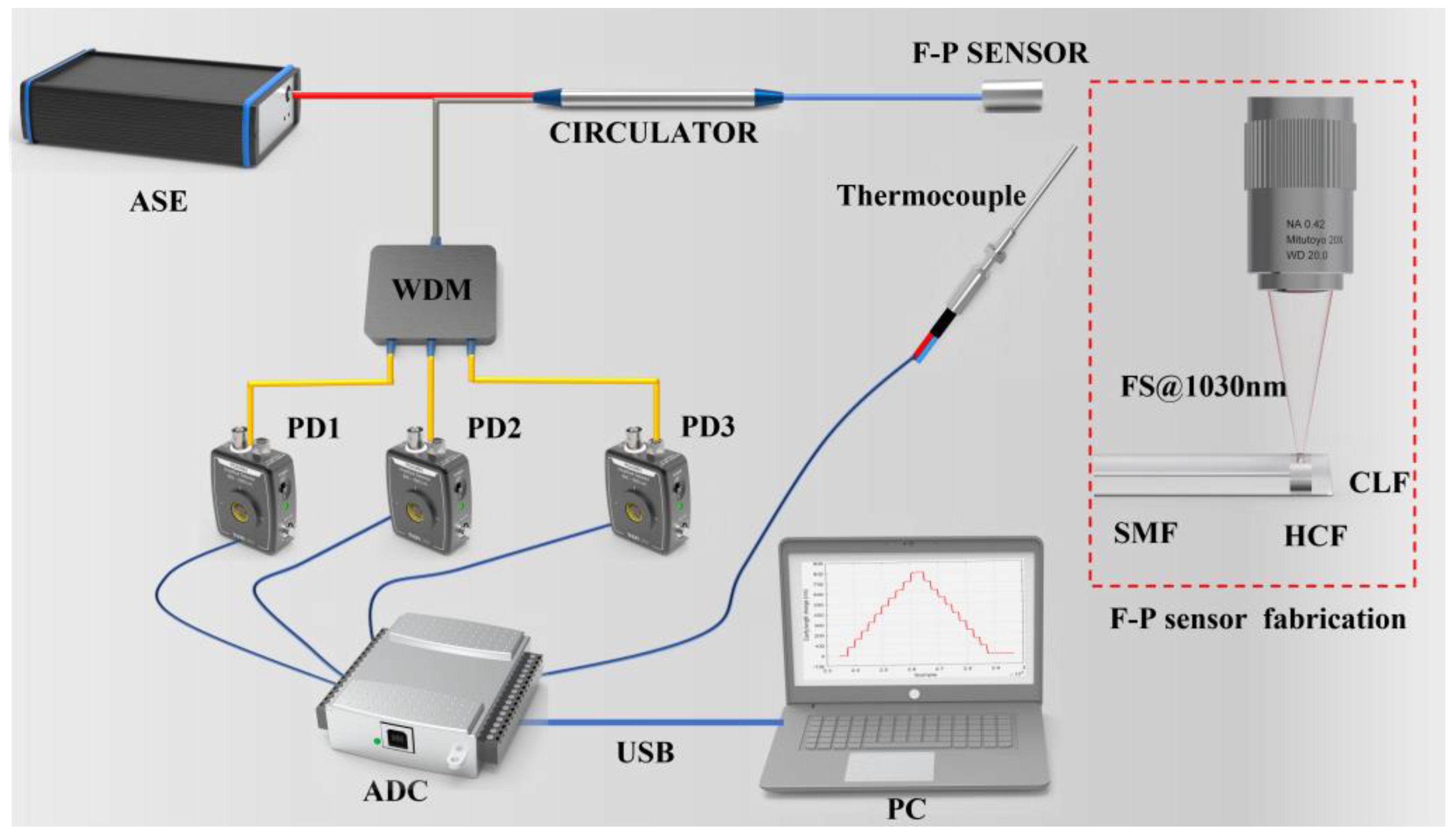
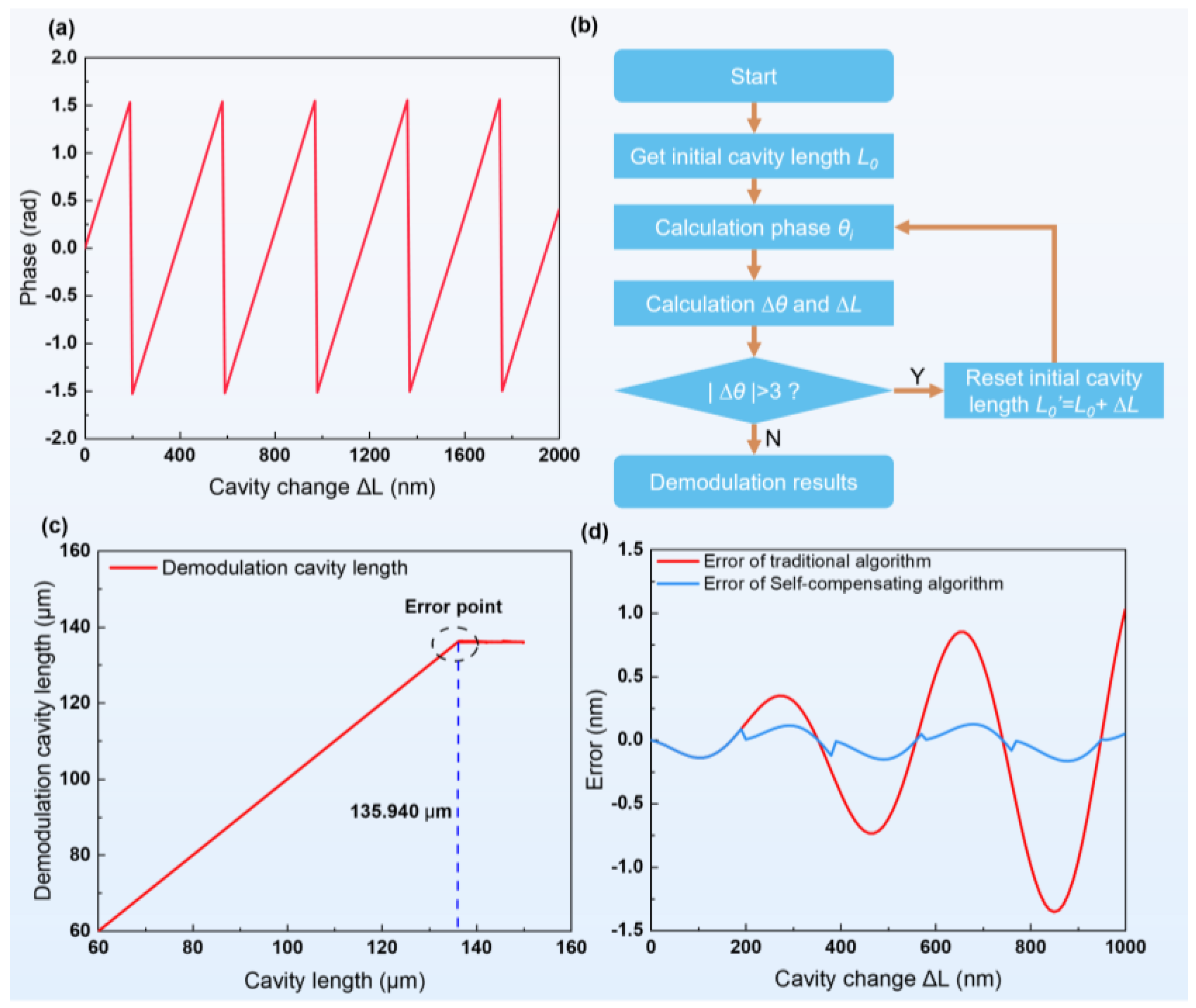
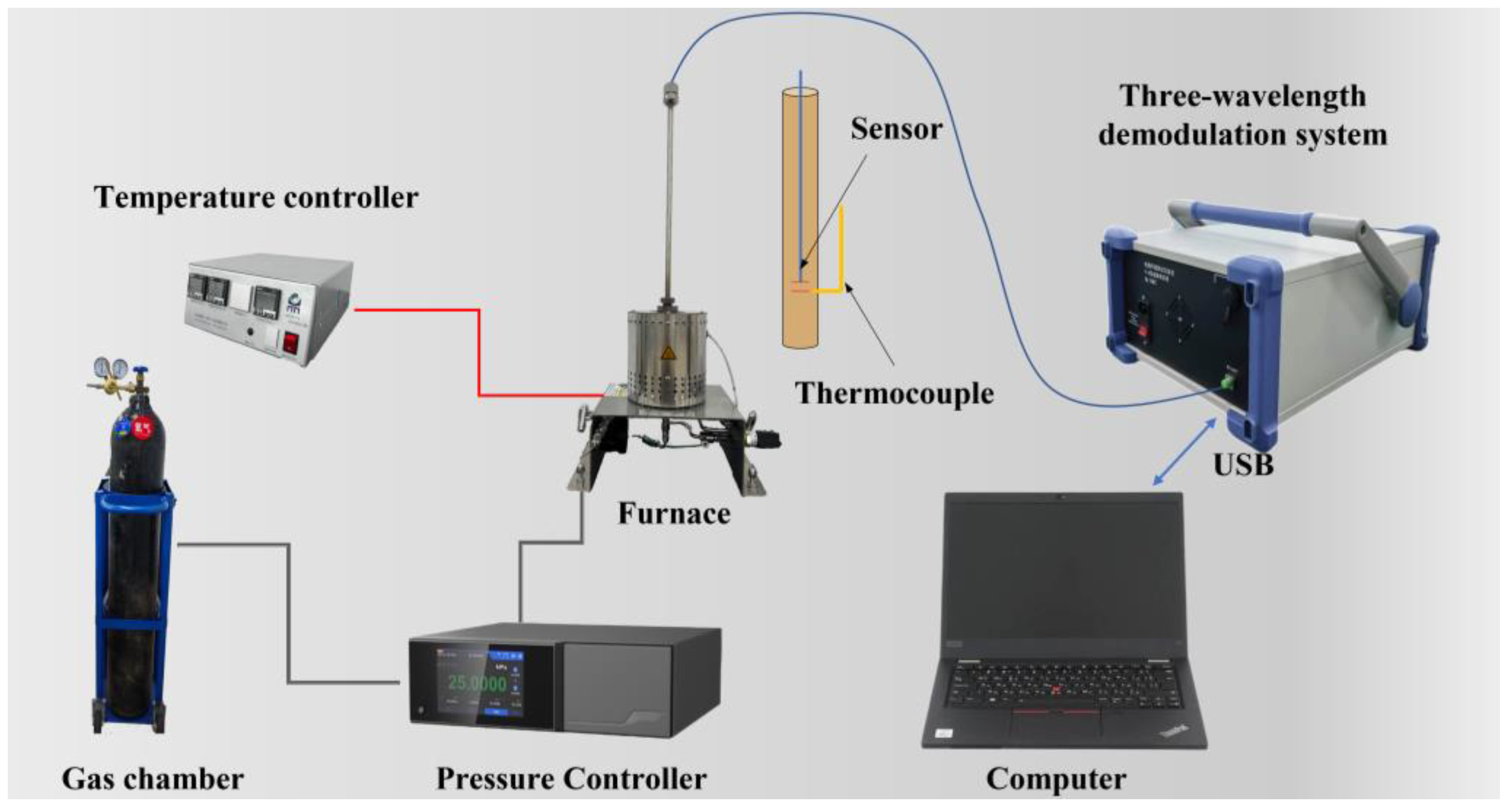
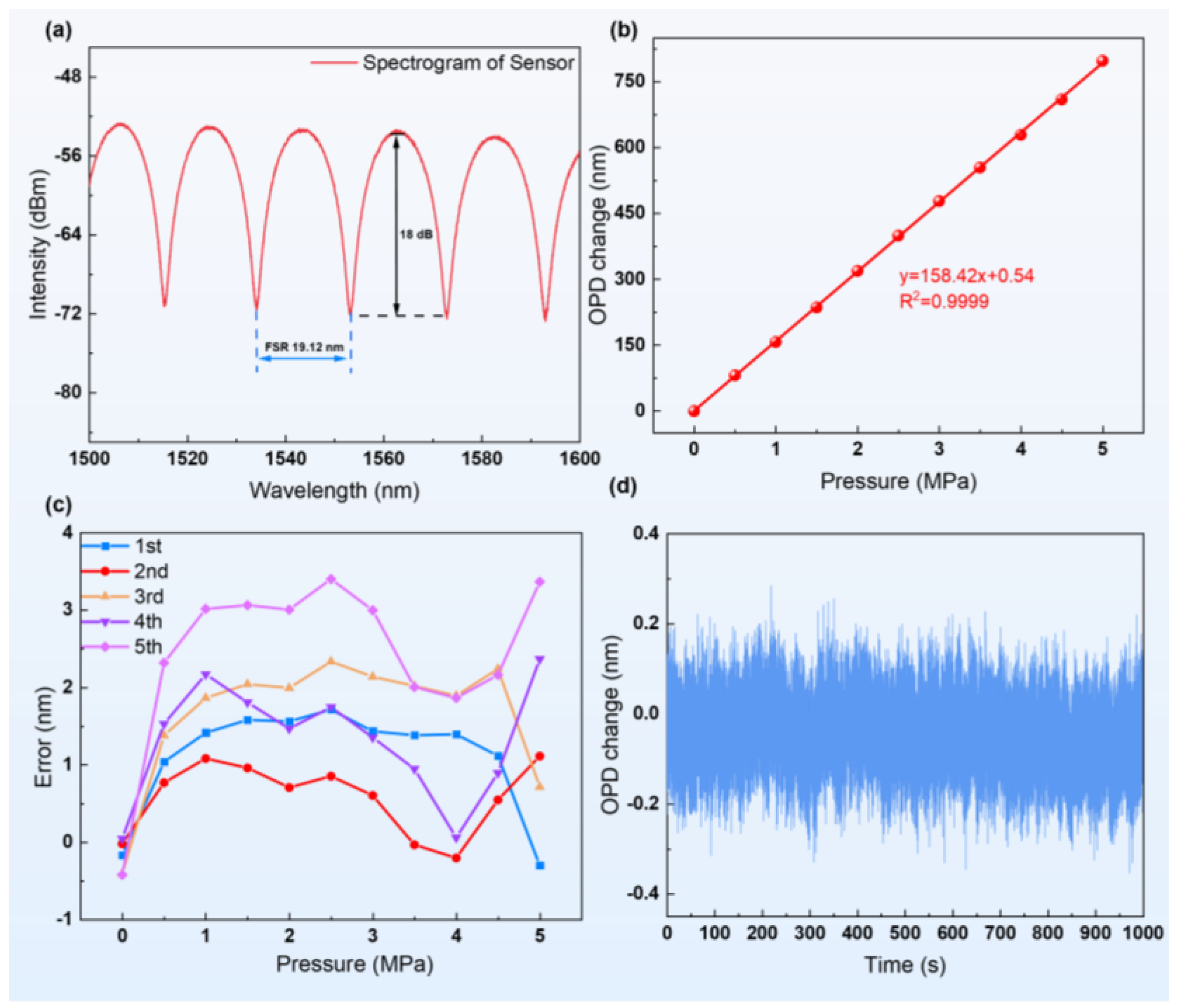
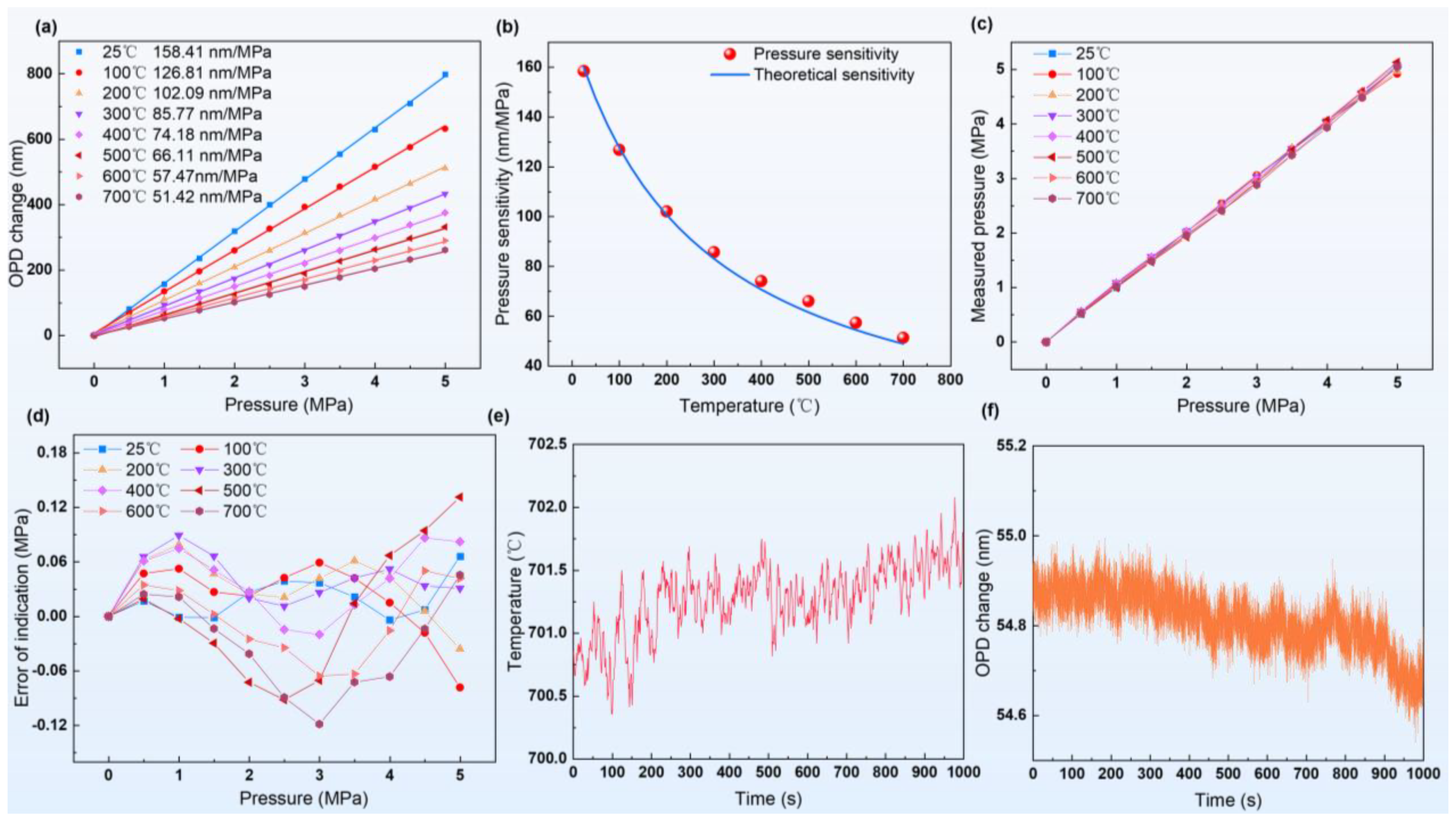
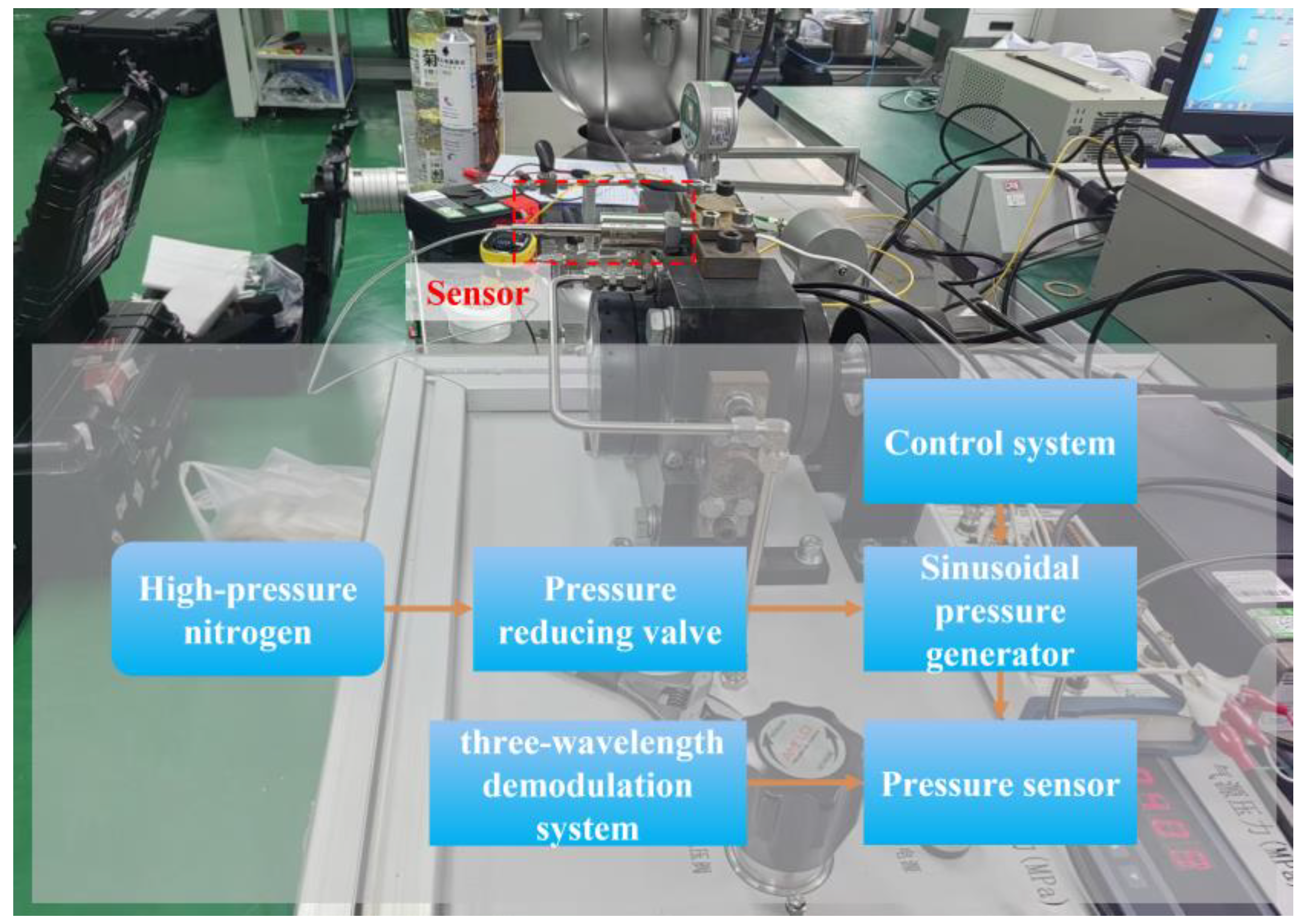
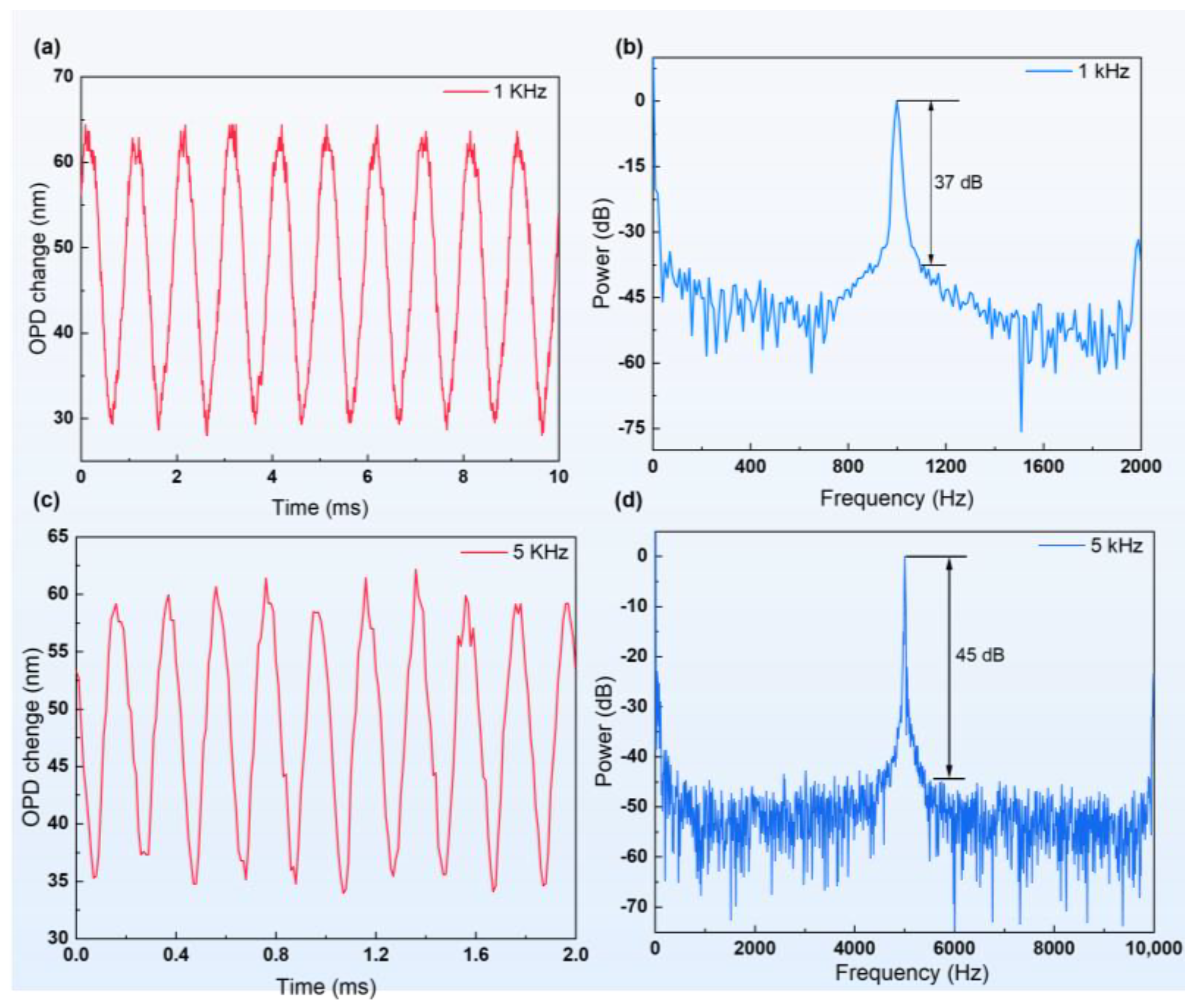
| Demodulation Method | Demodulation Speed | Demodulation FP Cavity Length | Verify the Type of Sensor |
|---|---|---|---|
| High-speed spectral demodulation based on scanning lasers [18] | 2 kHz | 300–130,000 μm | Vibration verification of piezoelectric ceramic |
| Three-wavelength phase demodulation method [23] | 20 kHz | 23.065–1094.703 μm | Vibration verification of piezoelectric ceramic |
| Self-compensation three-wavelength demodulation method [24] | 500 kHz | 44.885–83.347 μm | FP pressure sensor |
| Dynamic phase white-light interferometry [29] | 20 kHz | Not explicitly mentioned | FP vibration sensor |
| Demodulation based on dual Fizeau interferometer [30] | 100 kHz | 4.74 μm (range of variation) | FP vibration sensor |
| Phase demodulation method for high-speed spectrometers [31] | 20 kHz | Not explicitly mentioned | FP vibration/acoustic sensor |
| High-speed demodulation based on coarse spectrum [32] | 50 kHz | 25.66–684.13 μm | Vibration verification of piezoelectric ceramic |
| High-speed spectral peak-jump compensation demodulation [33] | 5 kHz | Not explicitly mentioned | FP high-temperature pressure sensor |
| This study | 200 kHz | 60–135 um | FP high-temperature pressure sensor |
Disclaimer/Publisher’s Note: The statements, opinions and data contained in all publications are solely those of the individual author(s) and contributor(s) and not of MDPI and/or the editor(s). MDPI and/or the editor(s) disclaim responsibility for any injury to people or property resulting from any ideas, methods, instructions or products referred to in the content. |
© 2024 by the authors. Licensee MDPI, Basel, Switzerland. This article is an open access article distributed under the terms and conditions of the Creative Commons Attribution (CC BY) license (https://creativecommons.org/licenses/by/4.0/).
Share and Cite
Guo, M.; Zhang, Q.; Zhu, H.; Liang, R.; Zheng, Y.; Zhu, X.; Wang, E.; Li, Z.; Xue, C.; Hai, Z. Performance Study of F-P Pressure Sensor Based on Three-Wavelength Demodulation: High-Temperature, High-Pressure, and High-Dynamic Measurements. Sensors 2024, 24, 5313. https://doi.org/10.3390/s24165313
Guo M, Zhang Q, Zhu H, Liang R, Zheng Y, Zhu X, Wang E, Li Z, Xue C, Hai Z. Performance Study of F-P Pressure Sensor Based on Three-Wavelength Demodulation: High-Temperature, High-Pressure, and High-Dynamic Measurements. Sensors. 2024; 24(16):5313. https://doi.org/10.3390/s24165313
Chicago/Turabian StyleGuo, Maocheng, Qi Zhang, Hongtian Zhu, Rui Liang, Yongqiu Zheng, Xiang Zhu, Enbo Wang, Zhaoyi Li, Chenyang Xue, and Zhenyin Hai. 2024. "Performance Study of F-P Pressure Sensor Based on Three-Wavelength Demodulation: High-Temperature, High-Pressure, and High-Dynamic Measurements" Sensors 24, no. 16: 5313. https://doi.org/10.3390/s24165313





